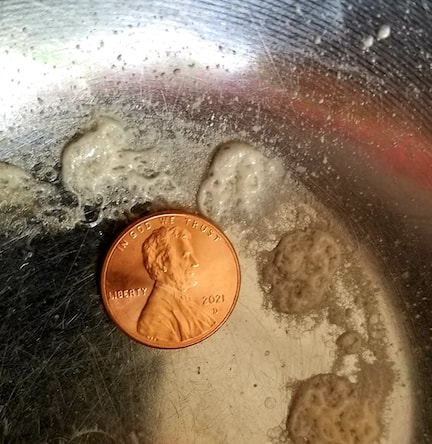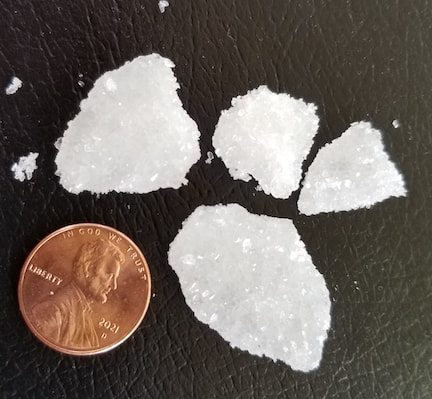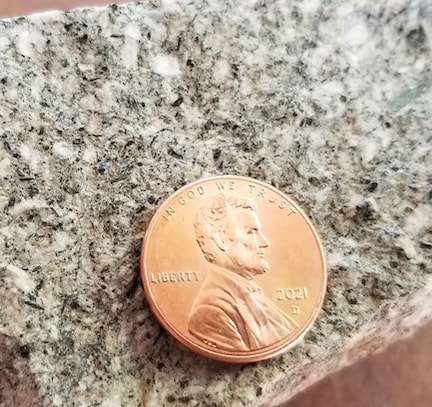I've used the word "texture" more than a few times now. Apparently the appearance of igneous rocks carries a message about the environment in which the rock formed. Let's explore this further.
Magma that breaks through Earth's surface to become lava will depressurize, perhaps boil, certainly thicken, and cool swiftly.
We've seen examples of bubbles trapped in lava. But now I want to draw your attention to the texture of the rock around the bubbles. Typically it is 'stony', as in flat and dull in appearance, although there may be some sharp-edged crystals mixed in.
Magma that breaks through Earth's surface to become lava will depressurize, perhaps boil, certainly thicken, and cool swiftly.
We've seen examples of bubbles trapped in lava. But now I want to draw your attention to the texture of the rock around the bubbles. Typically it is 'stony', as in flat and dull in appearance, although there may be some sharp-edged crystals mixed in.
Geologists use the word texture in a somewhat specialized way. Texture refers to the size, shape, and arrangement of the grains that make up a rock. (Students frequently think of texture in terms of roughness to the touch, but this is a different sense). And the first thing a geologist will note is whether a rock is "fine-grained" or "coarse-grained".
Imagine a pile of flour next to a pile of rice. The flour is fine-grained. You can't distinguish the individual bits. The rice is coarse-grained. You have no problem seeing the individual grains.
Magma erupted at the Earth's surface will cool and thicken quickly. Millions and millions of tiny silicate mineral grains will attempt to grow simultaneously, only to be defeated as the mobility of their constituent atoms is cut off by rapid cooling. This effect is worsened by the loss of "juicy" components like water, which escape into the atmosphere, rather than helping atoms arrange themselves into crystals.
We can mimic this effect by boiling down a solution of laundry borax in water. Millions of borax crystal grains are forced to grow simultaneously, while the watery medium feeding them evaporates away. Notice the flat, fine-grained, almost glassy texture of the resulting solid:
Imagine a pile of flour next to a pile of rice. The flour is fine-grained. You can't distinguish the individual bits. The rice is coarse-grained. You have no problem seeing the individual grains.
Magma erupted at the Earth's surface will cool and thicken quickly. Millions and millions of tiny silicate mineral grains will attempt to grow simultaneously, only to be defeated as the mobility of their constituent atoms is cut off by rapid cooling. This effect is worsened by the loss of "juicy" components like water, which escape into the atmosphere, rather than helping atoms arrange themselves into crystals.
We can mimic this effect by boiling down a solution of laundry borax in water. Millions of borax crystal grains are forced to grow simultaneously, while the watery medium feeding them evaporates away. Notice the flat, fine-grained, almost glassy texture of the resulting solid:
Magma trapped beneath the Earth's surface will cool much more slowly, and the confining pressure there will prevent the escape of fluid components like water.
We can mimic these conditions by letting the borax solution cool slowly over a few days. The watery solution stays liquid for a long time, allowing a relatively small number of borax crystal grains to grow into large sizes. Notice the clearly visible, coarse-grained texture of interlocking crystals:
We can mimic these conditions by letting the borax solution cool slowly over a few days. The watery solution stays liquid for a long time, allowing a relatively small number of borax crystal grains to grow into large sizes. Notice the clearly visible, coarse-grained texture of interlocking crystals:
Compare this look to the texture of this crystallized magma, which remained trapped beneath an ancient volcano. The rock is dense, with a texture of visible, interlocking crystals. There is no sign of bubbling gas and only a small proportion of the rock is fine-grained.
Early I mentioned that geologists are much taken up with the notion of environment. By observing the texture of an igneous rock, a geologist can decide whether she is looking at a lava, which cooled at or near Earth's surface, or looking at a crystallized magma, which cooled in a subterranean environment far below the former surface.
In her mind, the "rock" has become a "record", a historical document with a message from the past.
In her mind, the "rock" has become a "record", a historical document with a message from the past.





 RSS Feed
RSS Feed
